





by Theresa Welsh Author of “A Guide to Post-Industrial Detroit: Unconventional Tours of an Urban Landscape”
I wrote this essay in 2008, my last full year of working at a regular job before retiring in 2009, making time to explore and document a city in trouble. The photos here are all from before 2010.
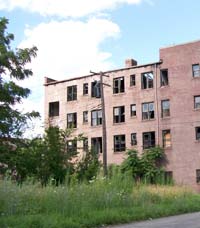
Every day on my way to work, I leave my street in Ferndale and drive a few blocks to Woodward Avenue, the main drag through the City of Detroit. Ferndale is an older suburb located just north of 8 Mile Rd, and a nice place to live. The houses are old, but well-kept, and the neighborhood is friendly and safe. But as I drive south on Woodward, lots of things change. I've become fascinated with the landscape of Woodward Avenue and have been taking pictures of what I see.
 Woodward Avenue got its name from Judge Augustus B. WoodwardA modest fellow, he named it after himself when he rebuilt the city in its current street layout in 1805 after a devastating fire swept through the city. Today Woodward Avenue is lightly trafficked, as so many people have left the city. It's a short drive to work for me, with nary a traffic jam.
Woodward Avenue got its name from Judge Augustus B. WoodwardA modest fellow, he named it after himself when he rebuilt the city in its current street layout in 1805 after a devastating fire swept through the city. Today Woodward Avenue is lightly trafficked, as so many people have left the city. It's a short drive to work for me, with nary a traffic jam.
|
As I turn onto Woodward Avenue, it just takes a few minutes to reach the bridge over 8 Mile Rd, a bridge built and recently renovated, because at one time the traffic was very heavy at this intersection of two major highways; 8 Mile Road separates the City of Detroit from its Oakland County suburbs. Many local citizens had wanted the bridge taken down, since it is no longer justified by the traffic, but the Michigan Dept of Transportation decided to restore it, and adorned the exterior of its three levels with large reproductions of old photographs of the area. Former Glory, Shrinking Population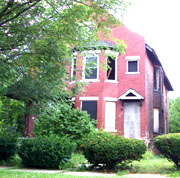
Detroit has a wonderful history, and landmarks and evidence of that history are everywhere. There are so many historic sites along Woodward Avenue that in 2002 it was named one of America's "Scenic Byways." Founded in 1701 as a fort and trading post, Detroit was once the stove capital, building the sturdy "Detroit Jewell" gas stoves, and later became, as almost everyone knows, the auto capital. The Motor City. Home of the Tigers, Lions, Pistons and Red Wings. Home of Henry Ford. Birthplace of General Motors. And once home to close to two million people. But how many are left? Beginning with the riot in 1967, the year I married David and the year I was living less than a mile from where the riot started, the city began a steadydecline. I have lived in and out of the city over the years, and my daily drive down Woodward brings back memories of those years.
Home of Henry Ford and the Assembly LineOn the east side, the mall is named Model T Plaza for the old Model T factory just beyond it (the photo on the right —the red building— is Henry Ford's historic office building, with the factory beyond it). Highland Park is where Henry Ford built his original automobile for the masses, home of the moving assembly line and the $5 a day wage. At the Detroit Historical Museum (also located on Woodward Avenue) there is a photograph of this building with 12,000 workers standing in front of it. Henry Ford shut down the assembly line that day so the workers could assemble for the picture, which was taken during the boom period of the 1920s. Today, with a little imagination, you can still see the beautiful details of the office building, which was designed by famous Detroit architect Albert Kahn. No one uses the building anymore, but there is a historical marker in front of it.
Former Glory, Now in RuinsContinuing down Woodward, off a small stub street on the east side, is what remains of the former city center, the once-imposing City Hall building with its fancy brickwork and gargoyles along the top, and the old Fire Station next to it, with three big doors that must have once had flashy red fire trucks ready to roar out should there be a fire. But now the doors appear permanently shut and five-foot tall weeds protrude from the numerous sidewalk cracks. Across from City Hall is the old Police Station, an elaborate building made of brick and stone, with so many weeds pushing up through the concrete in front of it that you can hardly make out the entrance. I have turned off here to take a closer look and found the street that circles around the front of these buildings is so rutted with pot holes and cracking pavement and weeds popping through every crack as to leave me worrying about my tires. 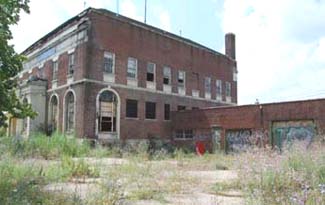
The old City Hall, with a few plywood pieces nailed to windows, has mostly lost its plywood and the front door is wide open. Inside, a Directory board clinging to peeling plaster lists offices for Public Saftety, with room numbers for Citizens Complaint Investigator, Criminal Investigation, and Commanding Officer. This seems to indicate city offices and police functions were combined at one point in this building. The marble pieces decorating the walls lie on a trash-strewn floor; broken glass is everywhere, and there are empty cans and bottles from visitors who have wandered in here, perhaps to find a place to shelter from storms or take a nap. I step gingerly past the old Information desk and imagine the graceful winding stairway full of people going about their business in what used to be a solidly middle-class community. Where are all the people who once worked here? Where are the residents who once got services here? People walk by on Woodward Ave and no one comes here, unless they are looking for a place to sleep off too many bottles of Wild Irish Rose. The old Police Headquarters building has been torn down and a new Fire Department building, financed with federal stimulus funds, has risen on the location. The old City Hall and old Fire Station are still standing, in an advanced state of ruin. Driving past the former City Hall complex just off Woodward, you get an impression of bricks covered with grafitti, lots of green plants in wild disarray and the look of an abandoned property. Which is what it is.
The Hotel Granwood finally met the wrecking ball and is gone. I cross over the Davison freeway, a short but historic freeway because it was the first freeway in the US, and there is the Oasis Shelter for Men, a former YMCA, a large older five-story building of attractive red bricks, and there's the usual sprinkling of men loitering out in front. It, and another well-kept building across the side street, a former YWCA, are operated by the Detroit Rescue Mission. Just beyond it is the New Mt Moriah church. A bit further down is a tree-shaded block, surrounded by a recently-erected wrought iron fence, with a spectacular building, the McGregor Public Library. It is a majestic grey stone structure on its own green oasis. I admire its recessed entranceway with the elaborate carvings on a half-dome ceiling, the door flanked by twin Corinthian columns. Soaring two-story windows are evenly spaced along the building, and you can imagine the place full of dark wood furniture and bookshelves from floor to high ceiling. Except that when you take a closer look, you see the heavy piece of plywood nailed over the tall front door and realize there probably aren't any books in there anymore. The windows have grates over them and it is obvious the place is not in use. At least someone is taking care of the grounds and it does not look like anyone has vandalized the place. Yet.
Architectural Gems in Highland Park
In the fall of 2009 the building was abandoned by its owner and residents had to move. In September of 2010 the building was torched by an arsonist; the fire left the building a burned-out wreck.
If you are absolutely fearless, you can get a heck of a nice big house for little money. Highland Park has so many vacant houses, you can buy one cheap, if you can find the owner (who may have just walked away from it) and pay for it before the vandals get there. Homes in Highland Park tend to be large, many in the Craftsman style, with big front porches, and many with large lots too. Lots of room for a flower garden and to grow some tomatoes and cucumbers in the back yard (or use one of the numerous vacant lots and grow a really big garden!). There are still nicely-kept homes here, but residential blocks are pock-marked with vacant lots, and falling-down neglected homes sit next to nice ones. These were once good neighborhoods and the commercial strip on Woodward once bustled with people visiting the stores and restaurants. There used to be a big Sears store on Woodward and it was the first place where David and I got credit back in 1967. Highland Appliance was where we bought our first TV set. It was a friendly, not scary, place back then.
Detroit and Highland Park houses. No one lives here. 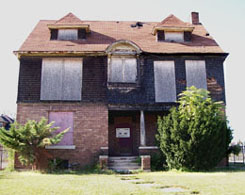 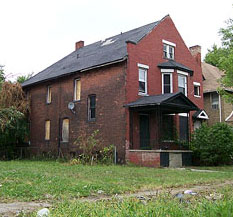 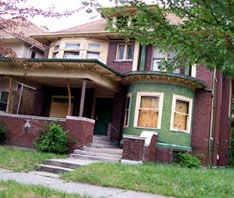
There are more memories further down Woodward. Highland Park, a city invented then abandoned by Henry Ford, is completely surrounded by Detroit, and you quickly leave it as you continue toward downtown Detroit. I drive by the block that used to have Aknartoon's Eatery in one of the storefronts and then only a peeling sign for it, but has been turned into the latest empty lot. I saw the wrecking equipment take big bites out the crumbling brick walls as I drove home one day. In a few days time, the space had been reduced to a smooth dirt lot, then gradually, assorted rogue plants started to grow in the dirt. 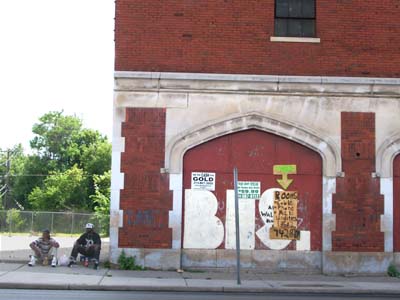 
Another block has empty storefronts, doors wide open and filled with trash. And yet another block with brick storefronts where only one is occupied, the rest forlornly covered with plywood or bars over windows. The second floor apartments look deserted, but the lovely brickwork with green tiles along the roof line give hints of its former glory. Abandoned apartment buildings facing side streets show broken glass and graffti. Home of the Auto Barons
Avenue of Historic ChurchesWoodward Avenue is also host to beautiful old churches, some still vibrant parishes, like Little Rock Baptist Church, and others just sitting there, their stone exteriors turned sooty, the bell towers silent, the parking lots empty. Many have changed congregations over the years and some have funny names, like Prayer Temple of Love Cathedral. You can read the past by taking a close look at these old structures. 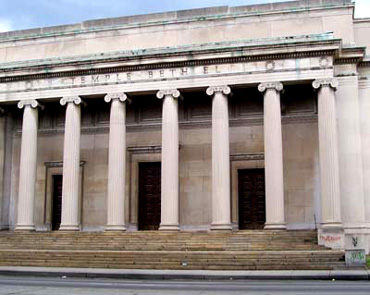
Consider the impressive Greek temple on the corner of Gladstone St, with its stone steps and tall Corinthian columns, with scripture quotes runing under the roof line on the side of the building. Large incised letters proclaim "Temple Beth El" along the top, above the Greek columns and tall ornate doors. You realize this is, or was, a synagogue. The Jewish migration out of Detroit began even before I came to live here, going first to Northwest Detroit, then out to Oak Park and now migrating to West Bloomfield and other locations. The former synagogue is now being used by Little Rock Baptist Church, but a perusal of a book on Detroit's historic churches reveals that Temple Beth El is the heritage of Detroit's first Jewish congregation, founded in 1850, and the beautiful building on Woodward was built in 1922, designed by the ubiqitous Albert Kahn, whose work can be seen up and down Woodward. Continuing down Woodward, a dark pinkish stone church with a circular tower structure rising from its midsection and two square towers flanking hefty stairs leading up to two massive red doors, has clearly been through some changes. "Woodward Ave Presbyterian Church" is carved in stone above the door, but the sign planted in the grass in front says "Abyssinia: An Inter-Denominational Church." Research shows this lovely church was built in 1911, and was part of a section of Woodward known as "Piety Hill" because it had so many churches. Most of them are still here, but for many, their congregations, like the baseballs our Tigers used to hit out of Tiger Stadium, are long gone. Many congregations departed the city during the influx of southern blacks who came for jobs during the boom years of World War II. The Neo-Gothic church across the side street from Abyssinia has a historical marker in its lawn and I'd noticed workers doing cleaning and maintenance on the grey stone structure. The historical marker reveals that this building dates from 1909 and was originally the Woodward Avenue Congregational Church but was sold in 1953 to an African-American congregation that continues to worship there, a better fate than has befallen Abyssinia. Some of Abyssinia's stained glass windows in its round turret are broken and its weed-infested parking lot looks like it hasn't seen Sunday worshipers any time recently.
Every time I make this trip with David he begins speculating as to where the Carrier Air Conditioning place was and I answer that I'm not sure. When we were both students at Wayne State University, where we met, he had a wonderful apartment upstairs over the Carrier store. The place had no hot water or heat, but he only lived there during one summer season, and he paid only the first month's rent, refusing to pay after that as a protest againt the lack of heat and hot water. The apartment, with big windows that looked out onto Woodward, was large, with lovely woodwork, and we once gave a great party there. There was a bar across the street (with the oddly inappropriate name, Library Bar)patronized by the locals and frequently visited by police when fights broke out. But now we search the empty lots, looking for those places, or where they once were; which of the numerous weed-filled stretches that increase as you get closer to New Center and Wayne State were the places we remember? The Color Perfect photo lab we used to patronize. The optical place where I got my first set of contact lenses. City of Ghosts, City of History
The spire of the Fisher Building and looming structure of the former General Motors headquarters are up ahead. New Center! And I'm there. This area was developed to be a second downtown, anchored by the massive General Motors Building, now called Cadillac Place and housing offices for State of Michigan workers. The beautiful art deco Fisher building, a marble and gold-leaf temple to the once-prosperous city, was another of Albert Kahn's many contributions to Detroit architecture. The office buildings here, along with the facilities of the Henry Ford Health System, with its huge historic hospital on West Grand Blvd, make this area still seem alive; on a nice summer day people who work in these buildings are strolling the sidewalks. The city reached its population peak in the prosperous 1950s, with nearly two million people filling its homes, driving its streets, and enjoying its riverfront charms. But in recent times, Detroit has been losing about 5000 people every year, and even the dead are leaving. According to an article in the Detroit News (August 12, 2008), suburbanites are having their deceased family members moved from Detroit cemeteries to cemeteries in the suburbs. It seems they don't want to drive into Detroit to visit grandma's grave. But today, people have come here to work, and so have I. I've completed another drive down Woodward Avenue, and I'll see it all over again on my way home. UPDATE, 2015: The years 2008 to 2010 were rock-bottom years for the City of Detroit. Conditions in the city have improved very much since the bankruptcy of 2013, the election of Mayor Mike Duggan, and emergence from bankruptcy in 2014, with the city shedding a huge burden of debt. Since writing this, I have explored the many ruins of the city and produced two ebooks full of photos of the abandonment in all parts of Detroit. See all my essays about Detroit's past and its resurrection. Mayor Duggan has said we will know Detroit is coming back as a Great American City when its population begins to to rise again. I believe this will happen. |
|
MORE ABOUT DETROIT ~~ Index to all Detroit Web Pages
BOOKS ABOUT DETROIT
Find more
Books About Detroit |
Detroit's Spectacular Ruin: The Packard Plant Detroit's Most Spectacular Ruin!
eBook for Kindle and Other eReaders Only $6.95 BUY FROM: |
A Guide to Post-Industrial Detroit: Unconventional Tours of an Urban Landscape 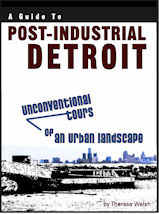 eBook for Kindle and Other eReaders Only $6.95 BUY FROM: |
|
BOOKS ABOUT DETROIT Click on a book image below to go to amazon.com for more information. | |||||||||
 |
 |
 |
 |
 |
 |
 |
 |
 |
 |
The Seeker Books Home Page More Detroit photos at 